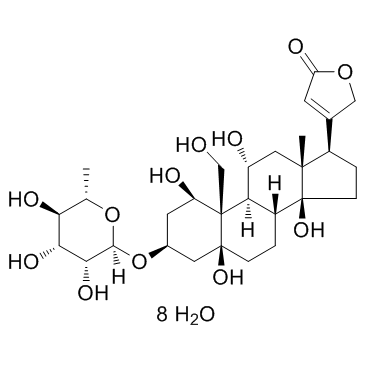11018-89-6
| Name | Ouabain octahydrate |
|---|---|
| Synonyms |
Card-20(22)-enolide, 3-[(6-deoxy-α-L-mannopyranosyl)oxy]-1,5,11,14,19-pentahydroxy-, (1β,3β,5β,11α)-
Ouabain a-L-rhamnoside G-Strophanthin (JAN) Strodival 4-[(1R,3S,5S,8R,9S,10R,11R,13R,14S,17R)-1,5,11,14-Tetrahydroxy-10-(hydroxymethyl)-13-methyl-3-{[(2R,3R,4R,5R,6S)-3,4,5-trihydroxy-6-methyltetrahydro-2H-pyran-2-yl]oxy}hexadecahydro-1H-cyclopenta[a]phenanthren-17-yl]-2(5H)-furanone Ouabain Oubain (1β,3β,5β,11α)-3-[(6-Deoxy-α-L-mannopyranosyl)oxy]-1,5,11,14,19-pentahydroxycard-20(22)-enolid Gratibain (1β,3β,5β,11α)-3-[(6-Deoxy-α-L-mannopyranosyl)oxy]-1,5,11,14,19-pentahydroxycard-20(22)-enolide (1b,3b,5b,11a)-3-[(6-Deoxy-a-L-mannopyranosyl)oxy]-1,5,11,14,19-pentahydroxycard-20(22)-enolide Astrobain OUABAIN OCTAHYDRATE Purostrophan EINECS 211-139-3 g-Strophanthin Octahydrate Card-20(22)-enolide, 3-((6-deoxy-α-L-mannopyranosyl)oxy)-1,5,11,14,19-pentahydroxy-, (1β,3β,5β,11α)- g-Strophantoside MFCD00003688 Acocantherin Gratus strophanthin STROPHOPERM |
| Description | Ouabain Octahydrate is an inhibitor of Na+/K+-ATPase, used for the treatment of congestive heart failure. |
|---|---|
| Related Catalog | |
| In Vitro | Ouabain (100 μM) induces NLRP3 inflammasome activation and IL-1β release in macrophages. Ouabain-induced NLRP3 inflammasome activation is mediated through K+ efflux[1]. Ouabain (3 nM) alters the expression of EMT markers in NHK and ADPKD cells, and modifies cell-cell adhesion properties in ADPKD. Moreover, ouabain enhances migration of ADPKD cells, selectively modulates tight junctions, and modulates adherens junctions in ADPKD cells in a selective manner. Ouabain also activates TGFβ-Smad3 signaling, alters TER in ADPKD cells[2]. Ouabain (25, 50 or 100 nM) treatment significantly reduces cell proliferation and viability in Raji cells in a dose-dependent manner, with IC50 of 76.48±4.03 nM. Ouabain increases the number of apoptotic cells, induces autophagy, and upregulates Beclin-1 in Raji cells[4]. |
| In Vivo | Ouabain (3 mg/kg) significantly decreases cardiac contractile force with an enlarged LVESD when mice are primed with LPS. IL-1β deficiency attenuates ouabain-induced cardiac dysfunction and injury. IL-1β secreted by infiltrated macrophages contributes to ouabain-induced cardiac inflammation. Deficiency of NLRP3 and Casp1 attenuates ouabain-induced cardiac dysfunction and macrophage infiltration[1]. Ouabain (30 µg/kg, i.p.) modulates ABCB1 activity in thymocytes of Wistar rats and it has the same effect on Swiss mice at 300 µg/kg. After 14 days of ouabain treatment, the MAP of rats is significantly elevated[3]. |
| Cell Assay | Cell viability is determined using a Cell Counting Kit-8 assay. Briefly, 100 μL Raji cells (5×104/mL) are seeded in triplicate in a 96-well plate and treated with various concentrations of ouabain (400, 200, 100, 50, 25, 12.5, 6.25, 3.13, 1.56, 0.78 and 0.39 nM) for 48 h. Following the 48-h treatment, 10 μL CCK-8 reagent is added to each well, and the cells are incubated for an additional 3 h at 37°C. Optical density (OD) values at 450 nm are subsequently measured, and each ouabain concentration is assessed in triplicate. Raji cells cultured in medium without drug served as controls. Cell viability is calculated according to the following formula: Inhibition rate (%)=[1 − (OD450(sample) − OD450(blank))/(OD450(control) − OD450(blank))] × 100. |
| Animal Admin | Mice[3] A total of 8 mice are used in the present study, 4 in the control group and 4 in the ouabain-treated group. Animals are maintained under standard laboratory conditions, with room temperature controlled (22°C), and subjected to 12 h light-dark cycles with ad libitum access to food and water. At 24 h subsequent to the intraperitoneal injection with 300 µg/kg of ouabain or PBS, the Swiss mice are sacrificed by barbiturate overdose (86 mg/kg intraperitoneal injection of pentobarbital). The mesenteric lymph nodes and thymi are immediately removed and softly dissociated. The remaining cells are washed in PBS and centrifuged at 200 × g. The pellet is suspended in ice-cold RPMI-1640 culture medium supplemented with 10% FBS until required for the activity assays. Rat[3] Male Wistar rats are treated with daily intraperitoneal injections of 30 µg/kg of ouabain or its vehicle, phosphate-buffered saline (PBS). A total of 20 rats are used, 12 for acute treatment (n=6 rats/group in ouabain and control groups) and 8 for chronic treatment (n=4 rats/group in ouabain and control groups). Animals are maintained under standard laboratory conditions, with room temperature controlled (22°C), and subjected to 12 h light-dark cycles with ad libitum access to food and water. Prior to the first injection at 24 h and 7 and 14 days subsequent to the injection, the rats have their blood pressure measured by a computerized tail-cuff method. The animals are sacrificed by barbiturate overdose (86 mg/kg intraperitoneal injection of pentobarbital) after 24 h (acute treatment) or 14 days (chronic treatment) of ouabain injections, and the mesenteric lymph nodes, thymi and blood are collected. Full excisions of thymi and partial excisions of mesentheric lymph nodes are performed, while blood samples are collected by caudal venous puncture prior to animals sacrifice. |
| References |
| Density | 1.5±0.1 g/cm3 |
|---|---|
| Boiling Point | 838.2±65.0 °C at 760 mmHg |
| Melting Point | 260ºC |
| Molecular Formula | C29H60O20 |
| Molecular Weight | 584.653 |
| Flash Point | 272.9±27.8 °C |
| Exact Mass | 584.283264 |
| PSA | 280.44000 |
| LogP | -1.64 |
| Appearance | powder | white |
| Vapour Pressure | 0.0±0.6 mmHg at 25°C |
| Index of Refraction | 1.655 |
| Water Solubility | H2O: 10 mg/mL cold | Soluble in water. |
CHEMICAL IDENTIFICATION
HEALTH HAZARD DATAACUTE TOXICITY DATA
|
| Symbol |


GHS06, GHS08 |
|---|---|
| Signal Word | Danger |
| Hazard Statements | H301 + H331-H373 |
| Precautionary Statements | Missing Phrase - N15.00950417-P260-P304 + P340 + P312-P403 + P233 |
| Hazard Codes | T: Toxic; |
| Risk Phrases | R23/25 |
| Safety Phrases | S45 |
| RIDADR | UN 1544 6.1/PG 1 |
| WGK Germany | 3 |
| RTECS | RN3850000 |
| Packaging Group | III |
| Hazard Class | 6.1(b) |

